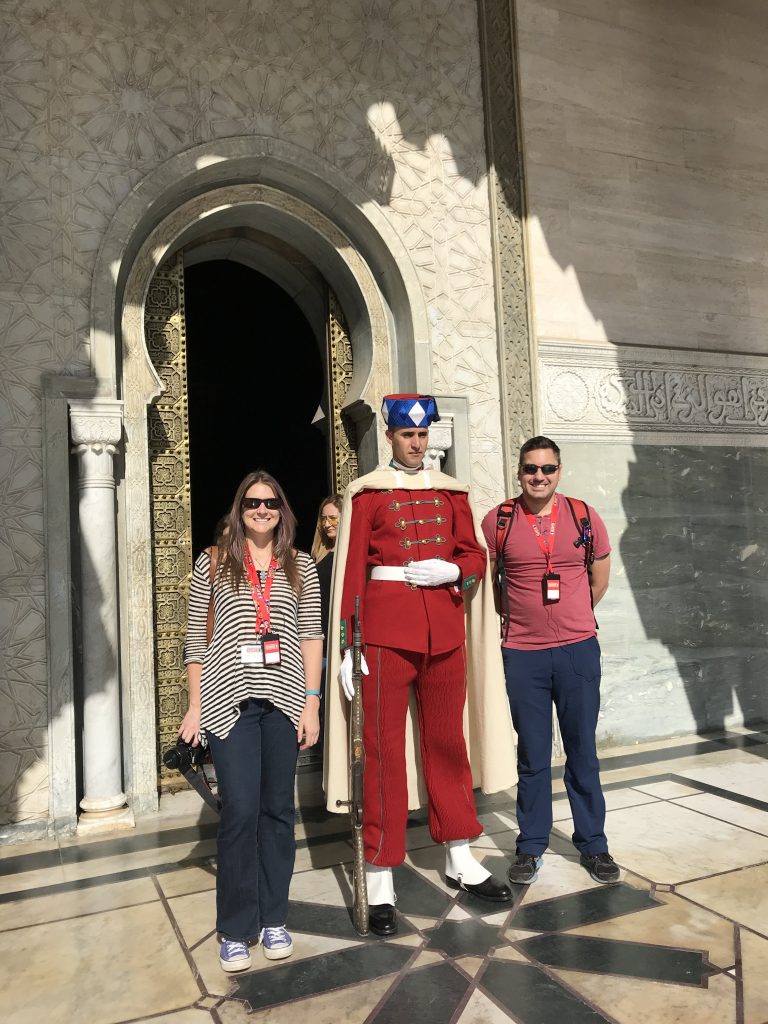We started to settle in to Rabat after a few hours sleep on our first day and our orientation meeting with Gate 1 Travel and our guide M’hamed after a 28 hour hour journey. We decided to head out for a local Moroccan dinner before getting a nice long sleep at Le Diwan Rabat (which by the way was a fairly decent hotel despite the smoking room mixup).
We used TripAdvisor to find La Koutoubia, about a 5 block walk from our hotel in a side street off Avenue Moulay Abdelazziz. This was our first taste of authentic Moroccan cuisine, and it didn’t disappoint. While it was a little quiet (it was a Wednesday night after all) with only a few other patrons in the main restaurant area (mostly foreign), it did appear there was another room in the back filled with a group of Moroccans, which gave us hope. The waiter for very attentive and helped us translate a mostly French menu in to English. We ended up with the fish and the chicken tagine. Pastilla is a Spanish word but uniquely Moroccan – it’s a pastry filo-like dough stuffed with meat and spices.

First night in Rabat
My chicken tagine was amazing as well, despite the fact I look exhausted! The restaurant also offered an array of mezze (olives and roasted almonds) as well as bread prior to the entrees coming – it was all amazing.
 After dinner, we walked back to the hotel and settled in to our first good night’s sleep in 3 days. We needed it.
After dinner, we walked back to the hotel and settled in to our first good night’s sleep in 3 days. We needed it.
The next morning, we got up and ready for a 9AM start, even making time for breakfast (not usually part of my morning routine). We found the breakfasts to me quite good on this trip, actually. We boarded the bus promptly and purposefully, having declined the wake-up call that Gate 1 decided to force on all all its travelers 2 hours in advance.
The first stop for our morning Rabat tour was the Royal Palace, which was the place of business (not the residence) of the King of Morocco (Mohammed VI, who has ruled since 1999).

Royal Palace in Rabat
We learned from M’hamed that the royal family was quite progressive – they chose to not live in the Royal Palace, breaking historical tradition, so that they could maintain a semblance of a private existence. They chose to live, instead, in Sale, across the river, which was the poorer area (but was also up and coming, and was the site of the new opera complex which was being constructed while we were there). His wife, Salma Bennani, was born in to the middle class and gained an engineering degree at a private college, only to fall out of public life after marriage. While she did chair several charitable foundations, under the law could never become monarch in case of the death of her husband, only a princess. The rulers have two children – one prince and one princess, and the price would inherit the throne. If he died, the throne would go to Mohammed’s brother Moulay.
Mohammed passed a comprehensive reform bill in 2011 that, among other things, provided more protection and quality for women under the law and removed the infallibility clause of the monarch. However, if you examine the timing of the reform bill, it was probably more expedient than progressive, given the Arab spring sweeping through early that same year.
The Royal Palace seemed quite decadent from the outside and there was a parade of royal guards keeping watching outside, Windsor style.

Royal guards in Rabat
I began to acclimate to Islamic architecture again, which is my absolute global favorite. One of my favorite shots to do is a long hallway shot with repeating patterns, like this one. The Royal Palace in Rabat was one of many places in Morocco I would be able to practice this technique.

After the Royal Palace, we visited the Rabat Necropolis called Chellah in Sale, founded by the Phoenicians as a trading district but built to its current glory of tombs by the Arab Muslim presence in North Africa in the 7th century, and rebuilt by the Maranids in the 13th century. In between the Christians, Byzantines, and Berbers (Amazigh in Arabic) occupied the area. it was literally tomb built upon tomb over the centuries.
Some Amazigh drummers greeted us at the entrance.

The three most fascinating things to us were the storks that were everyone across the necropolis, nesting atop pillars, unfinished towers, and ruins alike. They made a very noisy “clack clack clack” sound with their beaks, and M’hamed explained that their beaks were so strong, they could kill snakes.

Storks at the Rabat Necropolis
The second was the orange trees, dotting the landscape. A host of gardeners were working on them while we were there, and a few few motioned to me to come down and try one so I did.

Orange tree in Rabat
The worker in the red hat was the one who motioned to me to come down. He presented me with 3 sweet smelling oranges.

The final thing that caught our attention was the cat lady who had set up a feeding station by the eel pool. Literally hundreds of cats, a little dirty but very affectionate. Oh, and an eel pool. M’hamed explained you could bring in boiled eggs to toss in the pool that the eels would jump at and devour, which was suppose to help bring fertility to any woman who threw one in.

After the necropolis, we continued on to another Islamic tomb and the unfinished Hassan tower started in the 12th century and the modern Mausoleum of Mohammed V. It stood near the old city in Rabat. At the front of Hassan Tower, stood a contingent of the royal mounted guard – they stand in 4 hour shifts daily.

Hassan Tower in Rabat
I wandered off from the main group for a bit and got some quiet shots of the guards and mausoleum before the throng of people descended.


Guard at the Rabat Mausoleum
Brendan found me eventually and we took some pictures together with the guards, after nearly having a heart attack for losing me. The guards were incredibly good sports – they had to have indefatigable patience I’m sure, similar to the guards at Windsor Castle in the UK.

 Here’s a picture of the unfinished minaret Hassan Tower, which was supposed to be part of the largest mosque ever built before the caliphate commissioning it died mid-construction.
Here’s a picture of the unfinished minaret Hassan Tower, which was supposed to be part of the largest mosque ever built before the caliphate commissioning it died mid-construction.

Hassan Tower in Rabat
I captured this precious picture of a father helping his child down the stairs to the prayer area.

The final stop on our tour for the day was the Kasbah, whose 12th century walls held myriad of wonder and a bustling neighborhood.

Kasbah in Rabat

M’hamed our tour guide from Gate 1
Inside, was the famed white city – with blue paint contrasting and reflecting some of the Jewish heritage of the country and the famous blue indigo that would be found throughout Fez as well.

A literal cat fight unfolding in Rabat
It reminded me a lot of Sidi Bou Said in Tunisia.

All sorts of wonders could be found within, including secret gardens, plazas, and common areas lush with foliage and life.

As well as stunning views of the Atlantic.

And oh so many beautiful doors!
 After the Kasbah, we were on our on own for the rest of the day. We decided to walk a bit to Le Dhow Restaurant, a restaurant and night club on a boat, anchored on one of the Atlantic inlets.
After the Kasbah, we were on our on own for the rest of the day. We decided to walk a bit to Le Dhow Restaurant, a restaurant and night club on a boat, anchored on one of the Atlantic inlets.

Le Dhow in Rabat

 The experience was exceptional and we’d recommend it to anyone. It also gave us a great opportunity for watching the boats in the water.
The experience was exceptional and we’d recommend it to anyone. It also gave us a great opportunity for watching the boats in the water.

After a French and wet lunch of caprese, a Mediterranean pizza, steak with mushroom sauce, and a bottle of Moroccan white wine (Sahari Reserve), we walked through the souk back to our hotel. We had our eye on buying art because we met a young American teacher (who had just moved to Rabat) having lunch with her father at Le Dhow, and she had just bought a beautiful piece of art from the souk. We saw a few galleries but basically struck out. The souk was very clean, and we really weren’t hassled by anyone – a huge contrast from Cairo. It was an easy, fun, and lively walk.

Walk through the Rabat souk
When we got back to the hotel after a 20 minute walk, we quickly turned it around and went to the museum of modern art, which was just around the block from us. It was not very good, and actually quite small. Ever since Bahrain I was on a mission to see Arabic-influenced modern art, and really only have ever seen this in Doha. In Rabat, disappointingly, most of the art was Spanish except for one small photographic exhibition, which was not even particularly modern.
Afterwards, we headed back to the hotel again for a nap. We woke up around 9PM, then showered, ordered a snack through room service, and then went to bed for realzies around midnight for another full day the next and drive to Fez.

[…] group Discovery Gate 1 tour which can fit up to 22 people, offering a more intimate format than the Classic tour we took of Morocco in 2017. We were lucky enough to only have 17 people though. We got some beer/wine and snacks and sat down […]